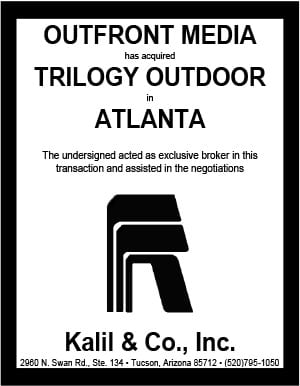 Sean Reilly was interesting as ever at this week’s Credit Suisse 21st Annual Communications Conference. Some of the highlights.
Sean Reilly was interesting as ever at this week’s Credit Suisse 21st Annual Communications Conference. Some of the highlights.
On how digital billboards promote better ad targeting
We allow customers to use trends on the small screen to inform what goes on up on the big screen. So the copy is always relevant. If something’s going on, trending on their facebook account, their twitter account, we take live feeds from that…And we use data and geofencing to allow what happens on the big screen to show up on the little screen. So picture a billboard and digital copy. Let’s say the customer is Bud Light. The demographic they’re going after is males 21-55…I check ESPN.com to get my sports scores. If this phone finds its way into a geofenced radius around that billboard the Bud Light ad shows up when I open up my ESPN.com app.
Does the whole industry need to work together?
As an industry it would be helpful if we had pipes that could talk across each other’s platforms. Because there are some markets that we can’t offer that some of our customers want…When we participate in a programmatic buy that…can be spread across multiple players.
Autonomous Cars and Out of Home
There’s two questions. One is, as 5G is deployed do we have an opportunity to participate in small cell leasing and having the carriers pay us to use our structures. That’s a small opportunity. We currently lease our structures to carriers to allow them to put up cell sites. It’s not a huge amount of money for us. It’s a little over a million dollars right now. But as more and more deployments happen in the 5G space a little more may come our way…The second question is…the autonomous connected car question. It’s hard to precisely talk about what is going to happen to consumer behavior when we don’t have to drive any more…We do have…an analogous situation in how we sell into transit settings…You’re not driving. But you’re still aware. We sell ads in and around a transit environment. I fully think we’re going to be talking to consumers whether they’re actually moving the wheel or just looking out the window. Right now when we ping a phone it’s not intrusive. It’s embedded in your app and you see it when you open your app. Because otherwise we’d be contributing to distracted driving. I guess if you’re not actually driving we can get a little more aggressive with that pinging.
What advertising categories are underrepresented?
Packaged goods…Fashion. High fashion. There are some companies that have inventory in places that are doing a better job than us. Think JCDecaux and their new digital bus shelters on 5th avenue…We are difficult to buy for pharmaceutical…a lot of it has to do with the disclaimers. It’s hard to get all the disclaimers up on a billboard.
On markets Lamar covets.
There are a couple of top DMA’s which would be helpful for us. LA. It’d be nice for us to have a large format presence in Los Angeles. We’ve got a real good presence in New York…a good presence in Chicago…a good presence in Philly…a good presence in Dallas, Atlanta…We’re missing Miami, we’re missing San Francisco, we’re missing LA.
On designing an open programmatic ad network
Our philosophy is open architecture. So when we built out API we made it very open. We’re not closed as some of our competitors are building proprietary and closed systems for their reasons. But we decided to go open. We want everybody to be able to plug and play in our pipes. When you go down that road the third party vendor can take care of your needs…It’s the same approach we have to measurement and attribution. We have customers that want different data sets to prove out where their spend is going and I don’t want to be wedded to one data set.
[wpforms id=”9787″]
Paid Advertisement

















